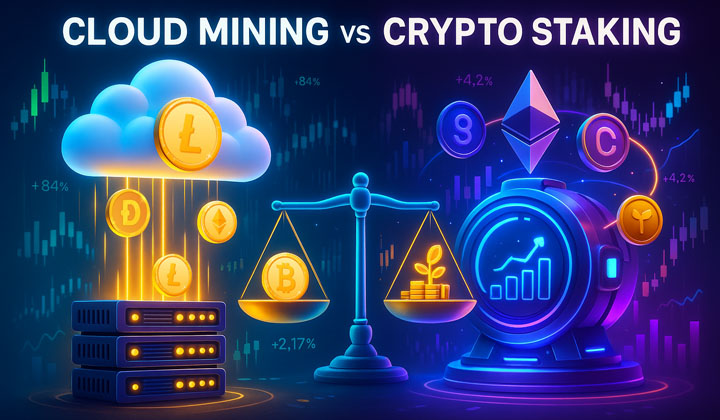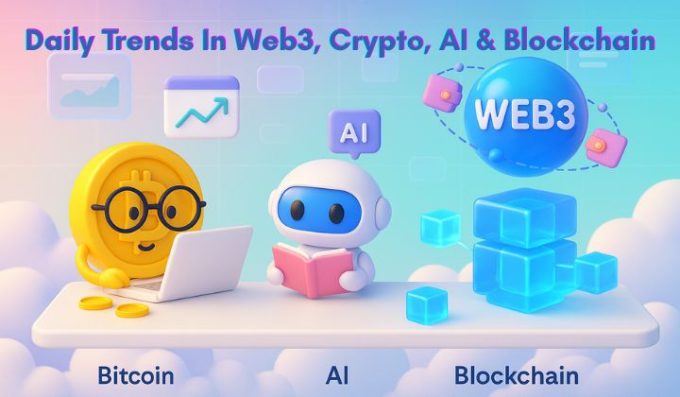
When it comes to earning passively in crypto, whether as a retail or institutional investor, cloud mining and crypto staking remain the two ways you can bolster your income.
Both methods offer two different paths to earning and creating digital wealth in the crypto space. But with changing market conditions, tightening regulations, and fluctuating network yields, the question of which method offers better returns in 2025 comes to light.
Is it cloud mining or crypto staking that’s better for you in 2025? We’ll break down each model’s operations, their profitability, risks, and the future of both methods, as the crypto space continues to evolve.
What is Cloud Mining and Crypto Staking?
Cloud mining is the use of hardware to earn passive income. Users purchase the hash power from cloud mining companies or large-scale remote data centers for a fee to mine cryptocurrencies like Bitcoin, which still runs on the Proof-of-Work consensus mechanism.
While cloud mining companies receive income from fees they charge users, the users earn daily rewards from renting the hash power. An example of a large-scale cloud mining company is Genesis Mining.
Crypto staking, on the other hand, involves locking up tokens on a Blockchain network to support its operations, like validation for a fixed reward. In this method, users stake tokens like ETH or SOL for a duration on a Proof-of-Stake Blockchain platform, and in return, they receive additional tokens.
These additional rewards come from transaction fees and inflationary rewards. Examples of staking networks are Cardano, Solana, Ethereum, and Polkadot.
So far, you can clearly see that both models differ in their earning mechanisms and operations. While cloud mining relies on computing power to earn, crypto staking depends on the network’s activities, including validation and security. Now, which method is more profitable in 2025? Let’s look at their profitability below.
Cloud Mining Vs Crypto Staking Profitability
When comparing the profitability of cloud mining and crypto staking, we’ll examine their expected yields/ROI, cost structure/barriers to entry, market volatility, security, and regulations.
Expected Yields
Average returns on cloud mining platforms differ under optimal conditions, such as network difficulty, hash rate, crypto price, and contract duration. During the last Bitcoin halving, which took place on April 19, 2024, the reward for mining a block of BTC fell from 6.25 to 3.125. The marginal rewards meant that miners earned less from mining.
But thanks to rising BTC prices above 100k for the better part of 2025 and improved ASIC efficiency, the profitability margin has been increased moderately. Now, miners can earn between 1.5% APY and 5% from mining pools, depending on the aforementioned factors. Short-term or smaller mining contracts generate less yield due to higher maintenance costs.
As for crypto staking, the returns have remained largely stable across all PoS networks, if not even higher. The APY ranges from 1% to 10% for popular networks, and between 10% and 14% for newer networks with a higher risk ratio.
On Binance Earn, for example, users can earn up to 10% on low-risk staking. However, data shows that Polkadot and Avalanche networks offer the highest average annual yields of between 7% and 10%.
Comparatively, staking offers better returns in lower volatility markets than mining. Plus, it’s less cost-intensive because no hardware is involved and energy isn’t expended, which affects the environment. It’s dependent on token prices, validator uptime, and network transaction fees.
Cost Structure & Barriers to Entry
Cloud mining involves several costs, from subscription maintenance to electricity costs. Users are expected to pay an upfront payment of between $500 – $10,000 and a maintenance fee of between $0.03 – $0.10 per kWh for a period of 1 to 3 years. The only advantage of this is that there’s no ownership of the mining equipment, but even that convenience comes at a heavy cost. Maintenance fees are deducted from your earnings, which affects the overall profitability. During market downturns, the profitability is even lower.
Staking, in contrast, offers a lower entry barrier, especially for retail investors. Users can stake directly from their wallets or exchanges with as little as $30, equivalent to the crypto.
Networks like Polkadot have no minimum staking value, and lock-up periods differ, which makes crypto staking a flexible option for people seeking better yield on a longer commitment. However, staking has liquidity risks, as you must lock up the tokens for a fixed duration before they are withdrawn. Once you commit, there’s no going back.
Also, staking carries technical risks like smart contract vulnerabilities. We’ve witnessed how smart contracts have been exploited, with these malicious players moving away with millions of dollars worth of crypto in these high-profile hacks.
Market Volatility & Reward Stability
Market volatility affects both, but in a different way. For example, hash rate and BTC price are fundamental to miners. In cases of market dips, operational costs can quickly turn into losses. This is quite bad because miners can’t adjust hardware mechanisms or relocate to cheaper energy zones.
Staking is vulnerable to token price volatility. Although staking yields are clear, transparent, and predictable, the Fiat value of the tokens fluctuates with changing market conditions. For instance, a 5% APY in ETH could still result in a loss if ETH’s price dipped 20% in a month.
So comparatively, cloud mining rewards are dependent on costs, while crypto staking depends on market conditions.
Security & Custody Risks
Security remains an essential factor, whether for cloud mining or crypto staking. Cloud mining companies have historically scammed their miners with dubious, non-transparent contracts. Some providers vanish mid-way through the contract or fail to provide the history of the miner’s mining activity.
One report discovered that two Estonians, who own a cloud mining company, HashFlare, falsified claims of their mining capability, defrauding investors of $577 million. There’s also another report of a hosting site disguised as a mining service platform, BitClub Network, which defrauded its users $722 million.
Aside from mining scams, the miner has no control over the rented equipment or mined assets, and results could even be manipulated by the backend. This lack of transparency among cloud mining companies calls for due diligence before one can invest.
Crypto staking offers greater control over assets, especially non-custodial staking. The user funds remain in the wallet, but could be reduced if the platform suspects any malicious activity. They could slash the rewards, which results in partial loss. Users in custodial staking, that is, via exchanges, face counterparty risks.
Environmental & Regulatory Factors
Energy sustainability continues to dominate the regulatory landscape for mining in 2025, as the talk of switching to a more renewable source is heating up. PoW networks consume high amounts of electricity and significantly impact the environment.
Following the EU’s Green Mining Directive, many EU nations opted to restrict high-energy Proof-of-Work operations. This initiative drove many cloud mining companies to Kazakhstan and the United States, where renewable energy sources are more utilized.
Crypto staking, on the other hand, consumes 99% less energy than mining, which makes it a more viable option. The energy efficiency aligns with the global call for sustainability, making it an eco-friendly option for investors. Regulations are also brewing for staking-as-a-service platforms, as the US SEC aims to tighten regulations regarding auditing and compliance.
Best Coins for Each Strategy in 2025
Whether cloud mining or crypto staking, here are coins to dabble in for each strategy in 2025.
Best Coins for Cloud Mining
Bitcoin is by far the dominant coin in the PoW mechanism. It’s the most secure and transparent network using the PoW mechanism.
Litecoin is another. Although less popular than Bitcoin, LTC offers moderate profitability with reasonable mining costs. Bitcoin and Litecoin are the two most popular digital coins for cloud mining.
Best for Crypto Staking
Ethereum is the most widely used coin for staking, with consistent yields over the years. The volatility rate is significantly less than other PoS coins, making it a great choice for staking.
Solana is another. It is one of the fast-growing ecosystems with competitive APYs for stakers. Solana has had its fair share of ups and downs over the past two years, from market crash to service disruption. However, the PoS network has become better.
Other coins to consider are Polkadot (DOT), Cardano (ADA), and Avalanche (AVAX). These ecosystems have attractive yields, stability, and high throughput.
Future of Cloud Mining and Crypto Staking
In the coming years, cloud mining models and crypto staking models will see great improvements in operations with the emergence of flexible consensus models and tokenized mining power. Already, some cloud mining companies are integrating hashrate tokens to monitor mining activities and ensure transparent distribution.
On the other hand, staking protocols like Lido are allowing users to earn from staking without lock-up durations. This means you don’t commit to extensive lock-up periods before you can take your funds.
Final Verdict: Hybrid or Diversified Approach
Whether as a corporate or retail investor, cloud mining and crypto staking can bolster your income. To enjoy maximum benefits with reduced risks, blending both strategies is best. A balanced portfolio mitigates the risks of rising energy costs and token volatility.
Given the benefits and risks of both strategies, there’s no absolute winner. At the end of the day, it’s those who diversify that will enjoy both approaches.
You need to login in order to Like


















Leave a comment